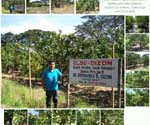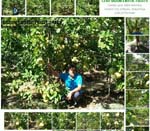 |
|
CLSU-DIZON |
|
PROJECT |
 |
|
|
|
Manila Bulletin, Agriculture,
Thurs., Sept. 28, 2000 |
|
Take a good second look at
the pummelo |
|
Agri Plain
Talk by Zac B. Sarian |
|
|
PEOPLE
who are looking for a profitable fruit crop to grow should
take a good second look at the pummelo.
Dr. Pablito Pamplona of the University of Southern Mindanao
reports that in Thailand investors are converting even
marshy farmlands into pummelo plantations.
The Thais have a very good reason for going into large
scale pummelo production. Dr. Pamplona observes that
pummelos, the good kind, have a constantly increasing demand
in the foreign markets such as Hon Kong, Taiwan, Japan,
Singapore and elsewhere.
One of the biggest advantages of pummelo is that it has
a long shelflife. It can be stored for as long as a month
from harvest without spoilage. Thus, when the price is not
right, it can be stored to wait for a better price. It can
be transported to distant markets even by ship which is much
cheaper than by air.
Another advantage is that it can be grown in many parts
of the country. It is not true that one can only grow the
best-tasting pummelos in Mindanao as some people think.
We have tasted excellent pummelos produced in Central
Luzon, in the Ilocos, from the Cagayan Valley and in
Southern Luzon. The superior varieties of Magallanes and
Nenita that are being grown in Mindanao also produce
excellent fruits in Luzon.
The secret is proper technology. According to experts
like Bernie Dizon, the key to producing fruits with superior
taste, aside from the use of the right variety, is balanced
fertilization. The fruiting trees should be provided with
enough potassium and ample amounts of trace elements so that
the fruits will be juicy and sweet.
The beauty about pummelos is that they don't occupy
much space. They can be placed five meters apart. They don't
also grow into very tall trees so the spraying and
harvesting operations are not as difficult as in the case of
mango trees that are allowed to grow tall.
Like many other fruit trees, pummelo does not like
waterlogged conditions. This can be remedied by providing
drainage canals between rows, or planting the trees on
elevated dikes just like what they are doing in Central
Thailand as reported by Dr. Pamplona.
One problem in pummelo production is the rind borer
that renders the fruits unattractive. This can, however, be
remedied by spraying the right pesticides as well as by
wrapping the fruits.
Dr. Pamplona is planning to come up with a technoguide
on pummelo production just as what he had done with durian
and longkong. That should go a long way in helping our local
farmers produce export-quality pummelo fruits |
|
|

